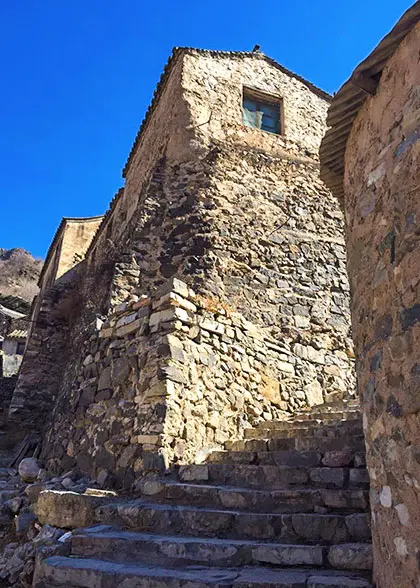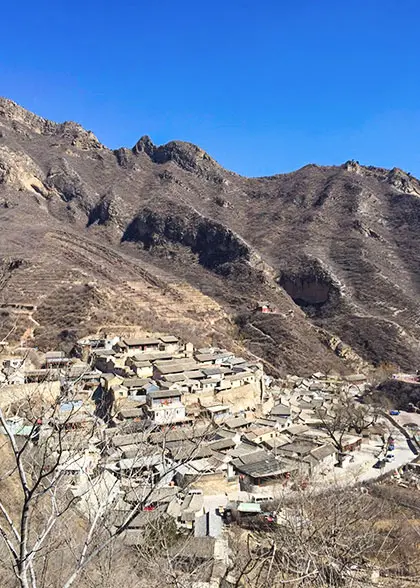Mentougou Travel Guide
 |
| Cuandixia Village |
Brief Intro: Mentougou District is a historically revolutionary area of Beijing. It has profound history and abundant tourism resources.
Location: west of Beijing, neighboring Haidian, Shijingshan, Fangshan, Fengtai and Changping districts and Laishui, Zhuolu counties in Hebei Province.
Geography: mainly mountains, high in the northwest and low in the southeast
Area: 1,455 sq km (562 sq mi)
Population: 238,000
Administrative Division: 4 Municipal Streets (Dayu, Chengzi, Dongxinfang, Datai); 1 Municipal Area (Wangping); 8 Towns (Tanzhesi, Yongding, Longquan, Junzhuang, Yanchi, Zhaitang, Qingshui, Miaofengshan)
Postal Code: 102300
Dialing Code: 010
Local Highlights: revolutionary tourism (red tourism), rural tourism and mountain scenery
Local Products: Jingbai pear, Gai persimmon, big cherry and walnut
Attractions
Scenic Spots: Cuandixia Village, Mt. Baihua, Mt. Lingshan, Miaofeng Mountain, Yongding River, Lingshui Village
Temples: Tanzhe Temple (Pool and Mulberry Tree Temple), Jietai Temple (Ordination Terrace Temple), Xifeng Temple
Fruits Picking Gardens: Fairy Deer and Peach Garden, Weidian Fruits Garden, Green Inlet and Red Persimmon Garden, East Mountain Pear Blossom Garden, Muchuan Fushi Apple Garden, Linggui Golden Apple Garden, Miaofeng Cherry Garden, Fairy Pond and Bird Garden, Lingyan Ecological Garden
Folk Custom Villages: Jiangshuihe, Hongshuikou, Bamuyan, Cuandixia, Jiuyuan, Dongmagezhang, Pingyuan, Zhaojiatai, Lingjiao, Jian'gou
Others: Yanhecheng Great Wall
As the largest river of Beijing, Yongding River is over 740 km (about 459.8 mi) long and the flowing area is about 47,016 square kilometers (about 18,153 sq mi). It flows through Mentougou District, Shijingshan District, Fengtai District, Fangshan District and Daxing District. It is Yongding River that helped form a particular mountain culture across Mt. Baihua, Mt. Lingshan and Mt. Miaofeng as well as a religious culture with Tanzhe Temple, Xifeng Temple and Jietai Temple as the Buddhist centers. The flow in the upper reach of Yongding River supplies excitement and thrills for tourists here.
 |
| Folk Houses in Cuandixia |
Mt. Baihua Scenic Area, also Baihua National Natural Reserve, first built in 1985, is the largest reserve for rare animals and plants. People call it Natural Wildlife Garden, which has over 1,100 species of plants including about 400 species of medicinal plants and about 170 species of animals including Panthera pardus, Crossoptilon mantchricum, goral, golden eagle and some other nationally protected animals. On the top of Mt. Baihua are Thousand-Buddha Peak (Qianfo Peak) and Kwan-yin Peak (Guanyin Peak) as well as the Dragon Pool and a couple of temple sites. Standing on the mountain, you would be lost in the elegant scenery.
Mt. Miaofeng is 1,291 meters (about 4,235.5 ft) in altitude, from which the Yongding River and Beijing City can be viewed in the far distance. Being famous for the distinctive temple fair culture of sacrificing Bixiayuanjun Niangniang (a fairy lady), Mt. Miaofeng is a special tourist site integrating the religious pilgrim, folk culture, natural landscape and humane relaxing condition. The Mt. Miaofeng Scenic Area has diverse Buddhist halls, such as Niangniang Temple, Shanmen Hall, Hall of the Medical King, Hall of the Heavenly Matchmaker (Yuelao Hall) and others. Dayun Temple Site on the mountain is said to be built under the imperial order of Wuzetian, the Empress of the Tang Dyansty (618 - 907), to extol her achievement. Additionally, at the foot of the mountain, an endless rose field will certainly be a feast for your eyes.
Xifeng Temple is well-known for its eight attractions: wisteria-pine twisting landscape in spring, old and exuberant trees in summer, bleak ancient steles in autumn and spring from the underground hall (actually it’s a tomb.) in winter as well as a narrow gorge in the east, lying Buddha in the south, Xifeng ancient corridor in the west and the carved lettering in the north.
Local Tourism Festivals
Mt. Lingshan Tibetan Custom Festival: in July each year
Useful Numbers
Tourist Complaint: 010-69843710
Consumer Complaint: 010-69844940
Ambulance: 010-69842951